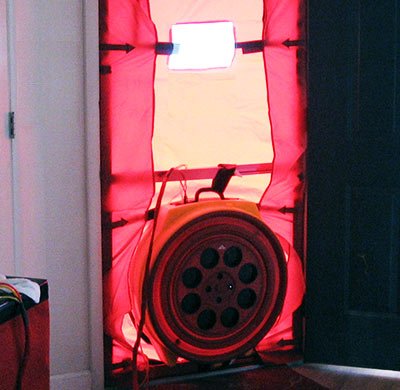Energy testing and thermographic imaging: The dynamic tools for better home diagnostics
The Role of Power Screening in Attaining an Airtight Option for Your Building
Energy screening is important for property proprietors looking for to develop an airtight environment. It recognizes air leakages and inefficiencies that can jeopardize power efficiency. Common perpetrators include gaps around doors and windows. Using approaches like blower door examinations and thermal imaging, property owners can acquire understandings into their residential property's vulnerabilities (energy testing). Recognizing these findings is crucial. What actions should be taken when air leaks are determined? The responses hold the secret to boosted convenience and savings
Understanding Energy Testing and Its Importance
Power screening plays a crucial function in assessing the airtightness of buildings and structures. By measuring air leak, this method supplies important insights right into a home's power performance, thermal comfort, and general performance. Airtight buildings lower energy intake, making sure that cooling and heating systems operate successfully. This screening process generally entails techniques such as blower door examinations, which create a regulated atmosphere to recognize unplanned air pathways.Understanding the significance of energy screening extends beyond conformity with building ordinance; it cultivates an aggressive method to sustainability. Determining air leakages early can cause timely removal, eventually enhancing interior air high quality and reducing utility costs. Additionally, energy screening contributes to the long life of structure products by reducing dampness buildup and related damages. As recognition of environmental influence increases, power screening becomes an essential device for builders and property owners going for high-performance residential properties.
Usual Sources of Air Leaks in Characteristic
Determining typical sources of air leakages is crucial for enhancing a home's energy effectiveness. These leakages commonly take place in numerous areas of a building, substantially impacting heating & cooling prices. Common culprits include gaps around doors and home windows, where seals might deteriorate gradually. Furthermore, electric outlets and buttons can develop paths for air exchange if not properly protected. Attics and basements are likewise constant resources, specifically where wall surfaces fulfill the foundation or the roofing. Other prospective leak points include plumbing infiltrations, airing vent systems, and the areas bordering chimneys. Older properties might endure from deteriorated building products, raising susceptability to air seepage. By acknowledging these common resources, building owners can take proactive actions to seal leakages, therefore improving overall power effectiveness and convenience within their rooms. Addressing these issues is a crucial component of establishing an impermeable service for any kind of residential property.
Methods of Energy Testing: Blower Door and Thermal Imaging
Efficient power testing methods, such as blower door examinations and thermal imaging, play a necessary function in diagnosing air leakages within a residential or commercial property. The blower door examination entails depressurizing a structure or pressurizing to gauge airflow and identify leaks. An adjusted fan is installed in an outside entrance, and the resulting stress distinction highlights locations of undesirable air seepage. This approach quantifies the general airtightness of the structure.Thermal imaging complements blower door examinations by visually detecting temperature level variants on surfaces, revealing hidden air leakages. Infrared electronic cameras catch warm loss or gain, permitting specific recognition of problem areas, such as badly insulated walls or gaps around windows and doors. energy testing taylors sc. With each other, these approaches provide a comprehensive evaluation of a building's energy effectiveness, enabling building owners to attend to air leaks successfully and enhance general efficiency
Benefits of Identifying Air Leaks
Recognizing air leaks uses substantial advantages for energy effectiveness and indoor comfort. By securing these leaks, structures can minimize power intake, resulting in lower utility expenses and a minimized carbon footprint. Furthermore, boosted airtightness adds to a more steady interior atmosphere, improving total convenience for passengers.
Power Effectiveness Improvements
Spotting air leakages is essential for boosting energy performance in structures. Recognizing these leakages enables property proprietors to address locations where conditioned air gets away or unconditioned air enters, bring about considerable power savings. By sealing fractures and spaces, structures can maintain a regular temperature level, lowering the demand on heating and cooling systems. This not just reduces power costs however also decreases the ecological effect connected with increased power intake. Furthermore, energy performance renovations contribute to a building's overall sustainability, making it a more eye-catching alternative for eco-conscious customers or renters. Inevitably, focusing on air leakage detection and removal aids enhance energy use, advertises accountable resource monitoring, and sustains long-lasting economic benefits for homeowner.

Boosted Indoor Convenience
Attending to air leaks not just brings about power savings but likewise considerably boosts interior convenience. When air leaks are properly recognized and secured, temperature level guideline within a residential or commercial property becomes extra effective. This causes regular indoor temperature levels, eliminating cold drafts in winter season and hot areas in summertime. Improved insulation additionally minimizes sound pollution from outdoors, creating a quieter and even more peaceful living setting. Additionally, enhanced air quality is attained by decreasing the seepage of outside contaminants, irritants, and humidity, adding to the general wellness of residents. Consequently, house owners experience a more pleasant environment, cultivating leisure and efficiency. Ultimately, why not look here identifying and rectifying air leaks is crucial for achieving ideal indoor comfort throughout the year.
How Energy Testing Boosts Convenience and Indoor Air High Quality
Power screening plays a necessary role in enhancing temperature law within indoor areas, ensuring a comfortable and constant setting. By recognizing and sealing air leakages, it additionally considerably decreases the infiltration of toxins, thereby boosting interior air top quality. This double influence promotes overall wellness for passengers.
Improved Temperature Level Law
Efficient temperature regulation considerably contributes to both comfort and indoor air top quality, making it an essential emphasis for modern-day building layout. Energy testing plays a crucial duty in accomplishing this regulation by identifying locations where warm loss or gain occurs, enabling targeted improvements. By guaranteeing an airtight structure envelope, energy testing helps maintain constant indoor temperature levels, lowering the demand for too much heating or cooling. This stability boosts resident convenience, as changes in temperature can bring about pain and discontentment. In addition, reliable temperature control can improve interior air high quality by minimizing the risk of condensation and mold and mildew growth, which flourish in unequal temperature problems. Consequently, power screening is crucial for enhancing temperature level management in household and industrial residential or commercial properties.
Decreased Toxin Infiltration
While many elements add to indoor air quality, lowered contaminant seepage stands out as an essential element that power screening can substantially enhance. Power screening determines air leaks and powerlessness in a building's envelope, which might enable outdoor contaminants, allergens, and dampness to get in interior spaces. By securing these leakages, homes can properly restrict air-borne contaminants, causing a much healthier environment. Improved airtightness not just improves convenience but additionally decreases the burden on home heating and cooling systems, resulting in energy savings. Additionally, lowered pollutant infiltration cultivates better general wellness for occupants, as cleaner air promotes breathing wellness and lowers allergy symptoms. Power testing plays a pivotal function in producing both a health-conscious and energy-efficient living space.
The Financial Effect of Power Testing on Utility Bills

Actions to Take After Energy Screening Results
As soon as energy screening results remain in, home owners must thoroughly evaluate the findings to figure out one of the most effective path ahead. The very first step entails identifying the areas that call for enhancement, such as air leaks or insulation shortages. House owners must then focus on repair services based upon the extent of the issues and their potential effect on energy efficiency.Next, it is recommended to speak with experts who specialize in power effectiveness to design a thorough activity strategy. This may include options like securing gaps, adding insulation, or upgrading windows and doors.After carrying out the necessary adjustments, a follow-up power test can identify the performance of the repair work. Continuous surveillance is additionally important to assure that the residential or commercial property maintains its airtight status with time. By following these steps, home owners can greatly enhance their residential property's power efficiency, resulting in lowered utility costs and enhanced comfort.
Often Asked Questions
Just how Often Should I Conduct Power Checking on My Home?
The regularity of energy screening need to usually be every few years, or complying with substantial restorations. Regular evaluations help recognize efficiency improvements and ensure that the home maintains perfect energy performance gradually, adjusting to altering conditions.
Is Energy Screening Necessary for New Constructions?
Energy screening is essential for new constructions, as it determines potential air leak and insulation issues - energy testing taylors sc. Applying these examinations warranties energy efficiency, boosts interior comfort, and fulfills building ordinance, inevitably leading to lasting cost savings
Can I Carry Out Power Testing Myself?
Energy testing usually needs specialized devices and competence. While some home owners might try standard evaluations, specialist solutions ensure accurate results and efficient recognition of issues, ultimately bring about much better energy efficiency and convenience in living spaces.
What Is the Price of Specialist Energy Screening Solutions?
The expense of expert power screening services typically ranges from $300 to $1,500, depending upon home size, location, and complexity. Home owners should take into consideration possible power financial savings when assessing the investment in these services.
How Much Time Do Power Testing Results Normally Last?
Power testing results generally remain legitimate for one to three years, depending on aspects like building adjustments and environmental changes. Normal updates are suggested to guarantee accuracy and keep reliable power efficiency requirements. Efficient energy screening methods, such as blower door tests and thermal imaging, play a click here now vital function in diagnosing air leakages within a home. Identifying these leaks enables property proprietors to address locations where conditioned air gets away or unconditioned air goes into, leading to considerable power cost savings. Energy screening identifies air leaks and weak points in a structure's envelope, which may enable exterior toxins, allergens, and dampness to go into interior rooms. As home owners progressively look for to minimize their energy expenses, the duty of power screening becomes essential in recognizing leaks and ineffectiveness. Property owners must after that prioritize fixings based on the extent of the concerns and their possible impact on energy efficiency.Next, it is a good idea to seek advice from with professionals that specialize in energy effectiveness to develop a detailed action plan.